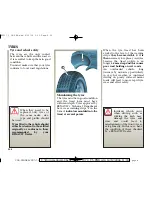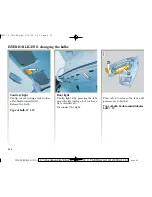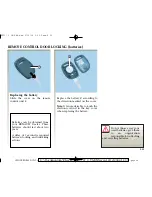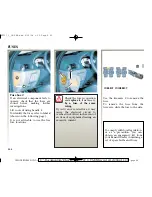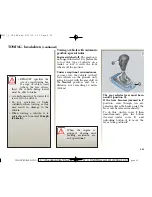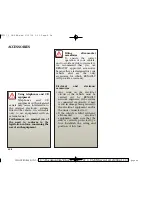
1
4
A
2
B
3
NU737_3_G5-FRA.qxd 2/11/04 9:15 Page 5.18
CLIO-TRICORPS NU737-3
C:\Documentum\Checkout\NU737_3_T5-ENG.win 14/12/2004 11:39
- page 18
5.18
BATTERY: breakdown
(continued)
Starting the vehicle using the
battery from another vehicle
Proceed as follows when starting
your vehicle from another vehicle’s
battery:
obtain the appropriate leads (large
cross-section) from a RENAULT
Dealer, or if you already have jump
leads, check that they are in perfect
condition.
The two batteries must have an
identical voltage: 12 volts.
Ensure that there is no risk of
contact between the two vehicles
(risk of short circuiting when the
positive terminals are connected)
and that the discharged battery is
properly connected. Switch off your
vehicle ignition.
Start the engine of the vehicle
supplying the current and run it at
an intermediate engine speed.
Attach positive cable (+) A to the (+)
terminal 1 of the discharged battery,
then to the (+) terminal 2 of the
battery supplying the current.
Attach negative cable (–) B to the (–)
terminal 3 of the battery supplying
the current and then to the (–)
terminal 4 of the discharged battery.
Check that there is no contact
between cables A and B and that
cable A (+) is not touching any
metal parts on the vehicle which is
supplying the current.
Start the engine as normal. As soon
as it starts, disconnect cables A and
B in reverse order (4-3-2-1).
Handle the battery with
care
as
it
contains
sulphuric
acid
which
must
not
come
into
contact with the eyes or skin. If it
does, wash the affected area with
plenty of cold water.
Ensure
that
naked
flames,
red-hot objects and sparks do not
come into contact with the
battery as there is a risk of
explosion.
Take care when working in the
engine
compartment
as
the
engine cooling fan may cut in at
any moment without warning.



